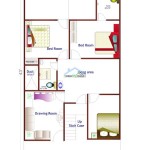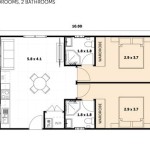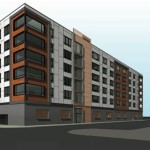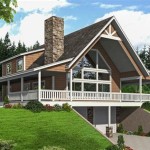4 Bedroom Simple House Plans: A Practical Guide to Design and Functionality
The demand for 4 bedroom simple house plans continues to rise, reflecting the evolving needs of modern families. These plans offer a blend of affordability, practicality, and sufficient space for comfortable living. Understanding the core elements of these plans is essential for homeowners seeking to build or renovate a dwelling that meets their specific requirements. This article explores various aspects of 4 bedroom simple house plans, emphasizing key considerations for effective design and functional living spaces.
Simplicity in house plans typically translates to efficient use of space, reduced construction costs, and ease of maintenance. A 4 bedroom simple house plan aims to maximize functionality while minimizing unnecessary architectural complexities. This often involves open floor plans, streamlined layouts, and the strategic placement of bedrooms and common areas to optimize natural light and ventilation.
Understanding Spatial Requirements and Family Needs
The foundation of any successful house plan lies in accurately assessing the spatial requirements of the occupants. For a 4 bedroom house, the size and composition of the family are critical factors. A family with young children may require bedrooms closer together and a larger common play area, while a family with older children might benefit from bedrooms with more privacy and dedicated study spaces. Therefore, understanding the family's daily routines, lifestyle preferences, and long-term needs is paramount.
Consider the size and purpose of each bedroom. The master bedroom should ideally be larger than the others, potentially including an en-suite bathroom and walk-in closet. The remaining bedrooms should be adequate for sleeping, studying, and storage. Determining the size of each bedroom will impact the overall footprint of the house and the arrangement of other rooms. Think about the functionality within each room and how the occupants would utilize the space. Consider furniture placement and accessibility to make the room feel more spacious and organized.
Beyond the bedrooms, common areas such as the living room, dining room, and kitchen are crucial for family interaction and entertainment. An open floor plan connecting these areas can create a sense of spaciousness and facilitate communication. The kitchen should be designed with functionality in mind, considering the placement of appliances, storage, and workspace. The dining room should be adequately sized to accommodate family meals and gatherings.
Storage is another essential consideration. Ample storage space can help maintain a clutter-free environment and improve the overall functionality of the house. This includes closets in each bedroom, storage in the kitchen and bathrooms, and a dedicated storage area for seasonal items and tools. Efficient storage solutions can maximize the use of space and prevent the accumulation of clutter.
Key Design Elements of Simple 4 Bedroom House Plans
Simple house plans often incorporate several design elements to enhance functionality and aesthetics. Open floor plans, strategic window placement, and efficient use of materials are common features. The overall design should prioritize natural light, ventilation, and ease of movement throughout the house.
Open floor plans create a sense of spaciousness and encourage interaction between family members. By eliminating walls between the living room, dining room, and kitchen, an open floor plan allows for a seamless flow of movement and a greater sense of connectivity. This design is particularly beneficial for families with young children, as it allows parents to supervise children while preparing meals or engaging in other activities.
Window placement is crucial for maximizing natural light and ventilation. Strategically positioned windows can bring natural light into the house and reduce the need for artificial lighting during the day. Windows should be placed to capture prevailing breezes, promoting cross-ventilation and reducing the reliance on air conditioning. The size and orientation of windows should also be considered to minimize solar heat gain during the summer months.
Efficient use of materials is paramount in simple house plans. Selecting durable, low-maintenance materials can reduce construction costs and minimize long-term maintenance expenses. Consider using locally sourced materials to reduce transportation costs and support local businesses. Sustainable materials, such as bamboo or recycled wood, can also be incorporated to reduce the environmental impact of the house.
The roof design is another important consideration. A simple roof design, such as a gable or hip roof, can reduce construction costs and simplify maintenance. The roof should be designed to effectively shed water and snow, protecting the house from the elements. Consider incorporating overhangs to provide shade and protect the walls from rain.
Finally, the exterior design of the house should be simple and functional. Avoid ornate details and complex architectural features that can increase construction costs and require more maintenance. A clean, modern exterior with simple lines and durable materials can create a visually appealing and low-maintenance home.
Optimizing Layout and Functionality within a Budget
Creating a functional and aesthetically pleasing 4 bedroom house plan within a budget requires careful planning and prioritization. Identifying essential features and making strategic design choices can help reduce construction costs without compromising on functionality. Consider opting for a smaller overall footprint, utilizing open floor plans, and selecting affordable materials.
One effective way to reduce construction costs is to minimize the overall footprint of the house. A smaller house requires less material and labor, resulting in lower construction expenses. This can be achieved by carefully planning the layout and maximizing the use of each square foot. Consider incorporating built-in storage and multi-functional spaces to optimize the use of space.
Open floor plans can also contribute to cost savings. By eliminating walls between the living room, dining room, and kitchen, an open floor plan reduces the need for materials and labor. This design also creates a more spacious and inviting atmosphere, enhancing the overall functionality of the house.
Selecting affordable materials is another crucial aspect of staying within budget. Consider using readily available materials that are both durable and cost-effective. Explore alternatives to expensive finishes, such as using concrete flooring instead of hardwood or opting for laminate countertops instead of granite. Researching and comparing different materials can help identify cost-saving opportunities without sacrificing quality.
Prioritizing essential features is also important. Focus on the core elements of the house, such as the foundation, roof, and electrical and plumbing systems. Invest in quality materials and workmanship for these essential components, as they will affect the long-term durability and functionality of the house. Consider postponing non-essential features, such as landscaping or decorative elements, until after the house is completed.
Consider the orientation of your house plans with respect to the sun. Proper orientation can reduce heating and cooling costs. In colder climates, orienting the house to maximize southern exposure can capture solar heat during the winter months. In warmer climates, orienting the house to minimize western exposure can reduce solar heat gain during the afternoon.
Furthermore, consider the flow of movement within the house. The layout should be designed to facilitate easy movement between different rooms and minimize congestion. Locate the bedrooms away from noisy areas, such as the living room and kitchen, to ensure privacy and quiet. Ensure that hallways are wide enough to accommodate furniture and people moving through the house.
Finally, remember to account for future needs and potential expansions. Consider planning for future additions or modifications, such as adding a bathroom or expanding a bedroom. Designing the house with flexibility in mind can help accommodate changing family needs over time.
In conclusion, a well-designed 4 bedroom simple house plan balances functionality, aesthetics, and affordability. By carefully considering spatial requirements, design elements, and budget constraints, homeowners can create a comfortable and practical living space that meets their specific needs and preferences. Planning is key to making the process smooth and the end product enjoyable.

House Plans 12x15m With 4 Bedrooms Home Ideas Bungalow Floor Design

Charming 4 Bedroom House 40 In Home Design Planning With Four Plans Designs

Best 25 4 Bedroom House Plans Ideas On Beach

4 Bedroom House Plans 2 Story Home Planning Ideas 2024 Two

Four Bedroom House Plans Perfect For Your Family Houseplans Blog Com

4 Bedroom House Plan Examples

4 Bedroom Southern Style House Plan With Big Front Porch

Newport Sketchpad House Plans

Budget Friendly 4 Bed House Plan 55150br Architectural Designs Plans

Low Budget Simple House Design Plans For Builders Blog Builderhouseplans Com








